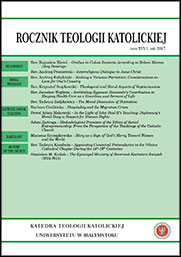Appointing Canonical Prebendaries in the Vilnius Cathedral Chapter During the 14th-18th Centuries
Appointing Canonical Prebendaries in the Vilnius Cathedral Chapter During the 14th-18th Centuries
Author(s): Tadeusz KasabulaSubject(s): Theology and Religion, History of Religion
Published by: Wydawnictwo Uniwersytetu w Białymstoku
Keywords: Grand Duchy of Lithuania; Vilnius; Diocese of Vilnius; cathedral; cathedral chapter; prelate; canon; coadjutor; patron; ius patronatus; prebendary
Summary/Abstract: The diocesan bishop enjoyed the right to fill cathedral chapter stalls and bestow patronages and benefices in medieval Western Europe, including in the Kingdom of Poland. However, a different practice developed in Lithuania in the Diocese of Vilnius, which was established in 1388. The King of Poland and the Grand Duke of Lithuania, Władysław II Jagiełło, founded the first Vilnius chapter when the Diocese of Vilnius was created. This chapter began with two prelates and ten canonical prebendaries. The next two prelatures: the custody (established before 1397) and the archdeacon (established in 1435) as well as the two canons, which were established in the early 16th century, were also grand-ducal or royal foundations. The king received and sustained these beneficiaries ius patronatus. The last two prelatures, cantoria and scholasteria, which Bishop Jan z Książąt Litewskich created, remained part of the bishops’patronage right from 1561 onward. The patronage right in the Vilnius chapter was established in the second half of the 16th century, when, in 1588, King Sigismund Augustus II gave the chapter the right to present candidates for the deanery. Compared to the cathedral chapters under the Polish crown, the diocesan bishop’s influence in filling the seats in the Vilnius chapter was definitely more modest, and even minimal, as it pertained to only two prelatures. The monarch, who could nominate up to three prelatures and all twelve canons, had incomparably greater rights. The bishop was vested ius patronatus with only two prelatures, and the chapter was vested with only one prelature. Once the chapter canon coadjutors appeared cum futura successione in the Vilnius capitular college, the Holy See was able to exercise a certain influence over filling the Vilnius chapter. A priest who was nominated as a canon coadjutor had to legitimize his appointment by presenting a papal bull that indicated his right of succession. This state of affairs lasted until the end of the 18th century.
Journal: Rocznik Teologii Katolickiej
- Issue Year: 16/2017
- Issue No: 1
- Page Range: 171-188
- Page Count: 18
- Language: English

